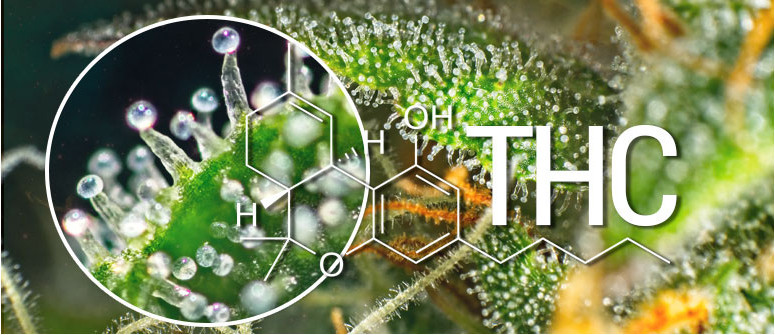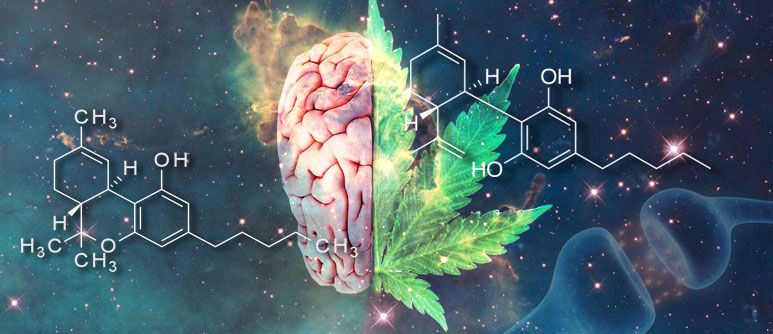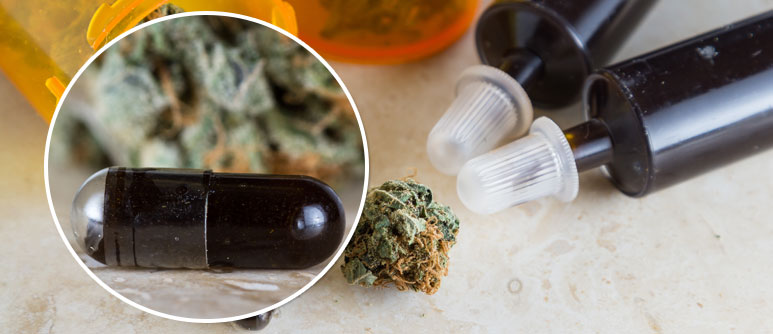What is THC (delta-9-tetrahydrocannabinol)?

Find out all there is to know about THC (tetrahydrocannabinol), the main psychoactive compound found in cannabis.
THC (or delta-9-tetrahydrocannabinol) is well-known as the main psychoactive compound in cannabis. But what exactly is this mighty cannabinoid and how does it interact with our bodies? Why do cannabis plants even contain THC in the first place? Should we be concerned about long-term THC use?
THC is the main psychoactive compound in cannabis and is one of over 80 different cannabinoids found in the cannabis plant.
When we consume cannabis, either by smoking, vaping, or eating it, these cannabinoids interact with various receptors located in our brains and bodies (which form part of the endocannabinoid system) to create various effects.
By interacting with these receptors, THC has a variety of effects on the body, causing feelings of elation, relaxation, euphoria, and more. We’ll cover the effects of THC in more detail below.
THC is usually the most abundant of all cannabinoids found in the cannabis plant.
THC VS. THCA
It is important to note that raw/live cannabis doesn’t contain THC. Instead, it contains THCA, or tetrahydrocannabinolic acid, a non-psychoactive cannabis compound.
During the curing and drying of cannabis, THCA slowly begins to convert into THC. Heat expedites this process, which is why we heat cannabis (either by lighting or smoking) in order to enjoy it.
THCA is a poorly understood cannabinoid. However, research suggests that it might have immense medicinal potential and could help to treat arthritis, cancer, neurodegenerative diseases, and nausea/appetite loss.
WHY DO CANNABIS PLANTS PRODUCE THC?
The cannabinoids found in cannabis plants are considered secondary metabolites, meaning they have no effect on the plant’s development and growth.
The highest concentrations of THC lie in the plant’s trichomes (the sticky, white hair-like growths that form on the flowers, leaves, and stems of mature plants). These trichomes are believed to play an important role in helping cannabis plants to fend off predators, pests, and parasites.
Because trichomes carry the highest concentrations of cannabinoids and terpenes, they are thought to help fend off animals and insects hoping to feed on cannabis plant’s while they’re flowering.
Trichomes are not unique to cannabis plants. The Venus Fly Trap, for example, uses trichomes to sense prey on the inside of its leaves. Tomato plants also have trichomes on their flowers. Some of the chemicals found in these trichomes are believed to help fend off herbivores.
HOW DOES THC INTERACT WITH OUR BODIES?
When we consume cannabis, the compounds in the plant enter into our bloodstream and distributed around the body where they interact with special cannabinoid receptors, CB1 and CB2.
These receptors are found all throughout the body, including the brain, spine, lungs, kidneys, and throughout the gastrointestinal, immune, and central nervous systems.
These receptors form part of the endocannabinoid system (or ECS), which is involved in managing a variety of physiological processes, including appetite, pain management, mood, and memory.
Our body is capable of producing its own cannabinoids, anandamide and 2-arachidonoylglycerol (2-AG), which interact with both CB1 and CB2 receptors around our body.
Anandamide, for example, is produced after exercise and may be responsible for the feeling of euphoria and lowered sensitivity to pain many people experience after exercising (colloquially called “runner’s high”).
Like anandamide and 2-AG, THC and other cannabinoids interact with the cannabis receptors in our body to produce the various effects associated with cannabis use. A lock and key analogy is often used to describe, in which the receptors in our bodies are the locks, and the chemicals found in cannabis (or produced by our endocannabinoid system) are the keys.
Much of the research behind the discovery of the endocannabinoid system in humans and other mammals is attributed to Dr Raphael Mechoulam, an organic chemist and professor at Hebrew University of Jerusalem in Israel.
WHAT ARE THE EFFECTS OF THC?
When THC interacts with the cannabinoid receptors in our bodies, it produces a variety of effects, both short and long-term.
It is important to remember that THC can affect people very differently. While it may make some people feel calm and peaceful, it can trigger anxiety in others. Similarly, while some might find that it lulls them to sleep, others might get nervous and restless.
Research isn’t quite clear on what causes these imbalances; they could be caused by the individual chemistry of our bodies or different concentrations of THC and how they interact with other cannabinoids found in cannabis.
Either way, we’ve gone ahead and listed some of the most common short and long-term effects of THC below. Remember, if you ever experience any unpleasant feelings while using cannabis, speak to your doctor immediately.
SHORT-TERM EFFECTS OF THC

The most common short-term effects of cannabis include:
- Elation
- Relaxation
- Sedation
- Pain relief
- Memory impairment
- Energy
- Hunger
- Drowsiness
- Increased heart rate
- Dry mouth
- Red eyes
- Slowed perception of time
- Laughter
- Dizziness
- “Couch-lock,” or feeling heavy
- Anxiety/paranoia
LONG-TERM EFFECTS OF THC
There is a lack of research into the long-term effects of THC to draw any real conclusions on how prolonged use of THC may affect our bodies.
In 2016, researchers at Cambridge University looked at how regular THC use from cannabis affects brain structure.[1]
The study looked at the microstructure of the corpus callosum (the region of the brain that connects the two hemispheres) of regular cannabis users, occasional users, and those who had never used cannabis at all.
The study found that regular consumers of high-THC cannabis strains showed different anatomical structures of the corpus callosum than occasional users or those that had never used cannabis.
The patients in this study self-reported how frequently they consumed cannabis, which is an important consideration, as there is no independent verification of the accuracy of the data provided by the patients.
The regular consumption of THC-rich cannabis has also been shown to increase the risk of psychosis in individuals who are already predisposed to the condition (or variations of psychosis, such as schizophrenia).
A 2016 study showed that regular cannabis consumption may fast-forward the onset of psychosis in predisposed individuals by up to 3 years.[2]
Recent research from cannabis experts at the Yale School of Medicine also shows that regular cannabis use builds up THC tolerance in individuals.[3] However, the research also suggests that tolerance returns to normal levels after roughly 2 days of abstinence.
Finally, another 2016 study published by the JAMA International Medicine Journal suggests that regular uses of THC-rich cannabis may lead to a decrease in memory. The study found that, for every 5 years of cannabis use, participants forgot 1 word from a 15-word list.[4]
MEDICINAL USES OF THC

There is no doubt that THC has certain medical benefits. However, the discussion about the medical potential of marijuana (and THC) is far from over, and there is still a strong need of more research into this field.
However, recent research suggests that THC may be beneficial for the treatment of:
- PTSD: THC has been shown to relieve some of the symptoms associated with post-traumatic stress disorder. Research from Brazil suggests it is extremely effective at disrupting contextual fear memory reconsolidation.
- Chronic pain: THC and other cannabinoids have been shown to reduce chronic pain associated with a variety of conditions, including everything from arthritis to fibromyalgia.
- Glaucoma: The only way to treat glaucoma is to lower intraocular pressure (IOP). Studies from the 70s suggested that cannabis may be beneficial in the treatment of glaucoma as it was shown to lower IOP in patients.
- Insomnia: Many cannabis users, both recreational and medical, claim to use cannabis as an evening nightcap.
- ^ Cambridge, Effect of high-potency cannabis on corpus callosum microstructure, retrieved January-15-2019
Link - ^ Science Direct, Cannabis use is associated with 3 years earlier onset of schizophrenia spectrum disorder in a naturalistic, multi-site sample (N = 1119), retrieved January-15-2019
Link - ^ NCBI, Rapid changes in cb1 receptor availability in cannabis dependent males after abstinence from cannabis., retrieved January-15-2019
Link - ^ Jama, Association between lifetime marijuana use and cognitive function in middle age, retrieved January-15-2019
Link
.jpg)
.jpg)

.jpg)
